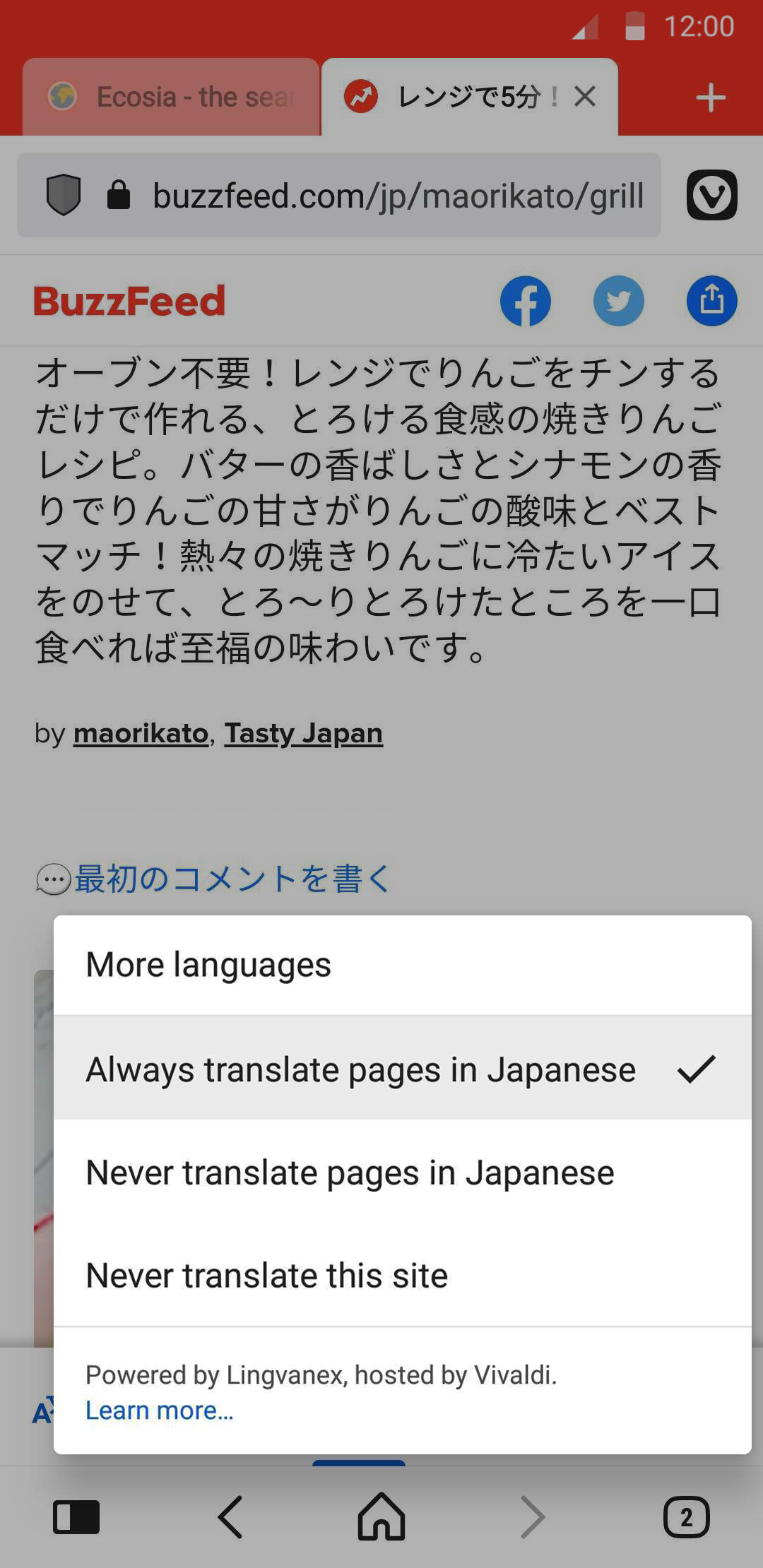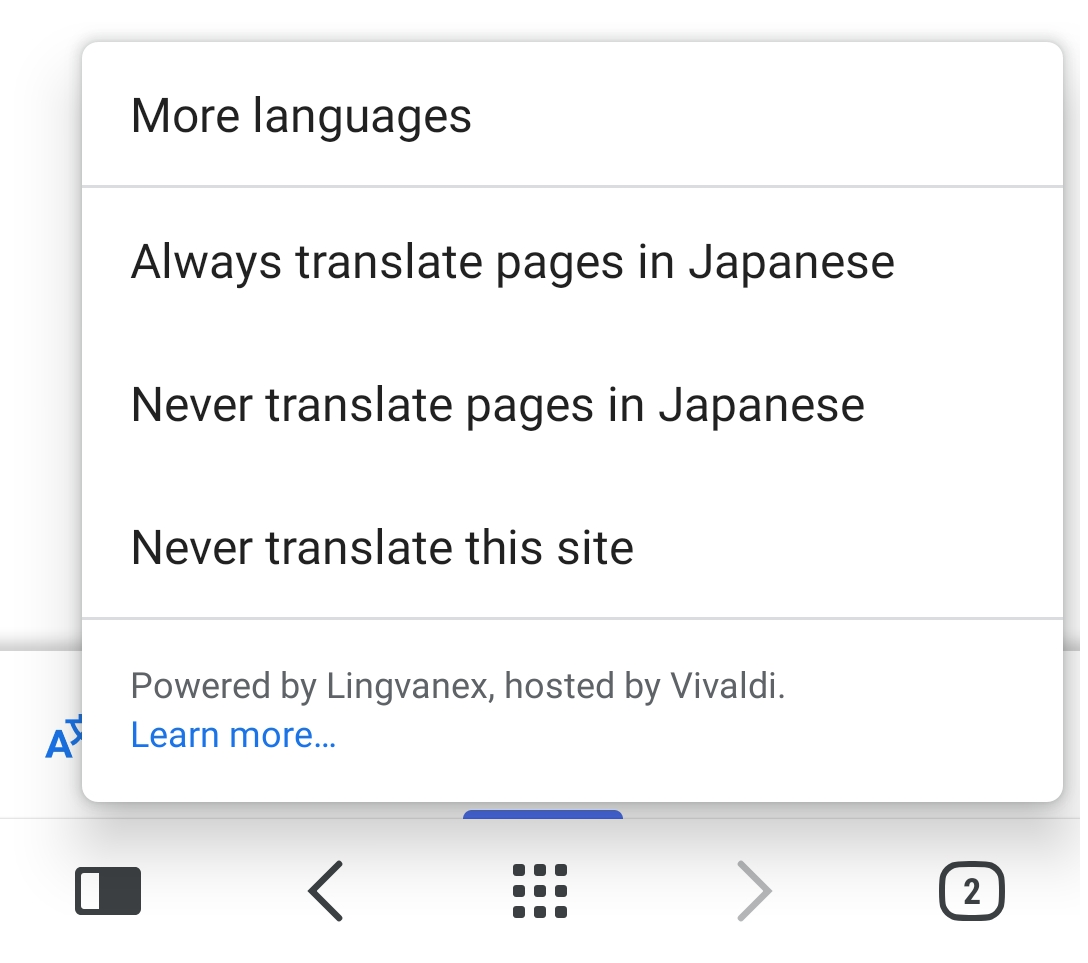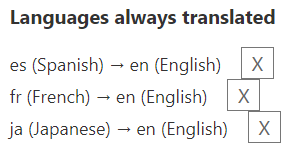Translate web pages on your phone
This post is also available in:
![]() 日本語
日本語 ![]() Français
Français ![]() Español
Español ![]() Deutsch
Deutsch ![]() Српски
Српски ![]() Українська
Українська ![]() Dansk
Dansk ![]() Português
Português ![]() Български
Български ![]() 简体中文
简体中文
With Vivaldi Translate, you can translate full web pages with just a click of a button. No Extensions needed.
Translate a web page
When a website you’re viewing is in a language different from your browser’s user interface language, Vivaldi offers to translate it for you. A banner will be shown just above the bottom toolbar for every language you haven’t made a decision about. The original language of the page is on the left and the translation language on the right. To translate the page to your default language, simply tap on the language on the banner.
To show the page in its original language again, tap on the original language on the banner.
In case, you closed the banner or it didn’t open after the page finished loading, open it from ![]() Vivaldi menu > Translate.
Vivaldi menu > Translate.

Translation options
In addition to translating the page to your browser’s default language, you can choose to translate into any of the supported languages. To change the translation language:
Option 1
- Click on the
 .menu button on the Translation Banner.
.menu button on the Translation Banner. - Click on More languages.
- Select a different language from the menu.
Option 2
- Go to
 Vivaldi menu > Settings > General > Language settings > Translation Settings > Advanced.
Vivaldi menu > Settings > General > Language settings > Translation Settings > Advanced. - Tap on Translate into this language.
- Select your preferred language.
To eliminate extra steps for future translations, you can enable or disable translation of certain languages and sites.
To change your preferences:
- Click on the
 .menu button on the Translation Banner.
.menu button on the Translation Banner. - Change your preferences.
Available options:
- Always translate – always translate the current language.
- Never translate – never translate the current language.
- Never translate this site – never be asked about translation on that particular site again.

Translation Settings
To disable or re-enable the automatic translation banner:
- Go to
 Vivaldi menu > Settings > General > Language settings > Translation Settings.
Vivaldi menu > Settings > General > Language settings > Translation Settings. - Toggle on or off Automatically offer to translate pages.
You’ll still be able to translate web pages from  Vivaldi menu > Translate.
Vivaldi menu > Translate.
Advanced settings
To review languages that you’ve chosen always and never to translate:
- Go to
 Vivaldi menu > Settings > General > Language settings > Translation Settings > Advanced.
Vivaldi menu > Settings > General > Language settings > Translation Settings > Advanced. - Click on Automatically translate these languages or Don’t offer to translate these languages, depending on which list you want to review.
- Tap on Add language to add a new language to the list or on the
 menu button next to a language already on the list to remove it.
menu button next to a language already on the list to remove it.
To reset a setting for a specific language or site:
- Type vivaldi://translate-internals in the Address Field;
- Go through the list of saved preferences.
- Click on X for the ones you want to reset.

Troubleshoot translation issues
When translation doesn’t work as expected, first reset the settings as instructed in the previous paragraph. If that doesn’t help, discuss the issue with the Team and Community on the Forum, to see if others can reproduce the bug or have suggestions for a fix.
To report a bug to the browser developers:
- Open vivaldi://translate-internals.
- Take a screenshot of the Prefs tab.
- Save the content on the Detection Logs tab by clicking on Dump above the table.
- Go to https://vivaidi.xyz/bugreport/.
- Fill in the form making sure to include the following information:
- Link of the page where translation fails.
- Your default user interface language and the language you tried to translate to.
- Other information that helps to reproduce the bug.
- Attach the files. You can also send the attachments after submitting the bug report in a reply email to the bug tracking system’s autoreply.
- Submit the bug report.